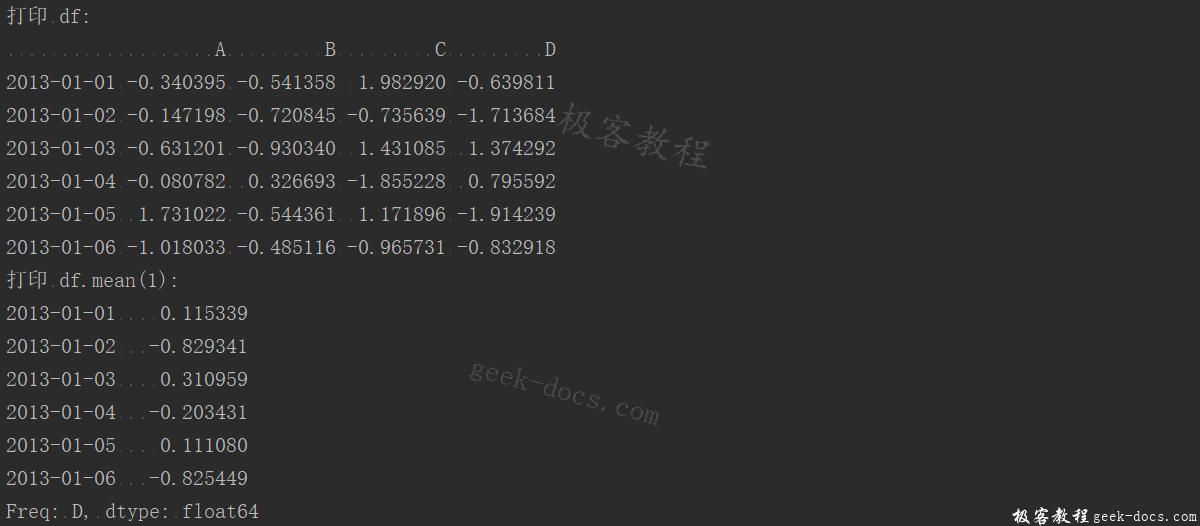Pandas 操作数据,本章介绍Pandas如何操作数据,包括统计函数(mean()),应用函数(Apply()),直方图化(value_counts()),字符串方法(str.lower())。
统计函数
在一些操作中经常会排除缺失值,进行描述性统计,如下例所示:
import numpy as np
import pandas as pd
dates = pd.date_range('20130101', periods=6)
df = pd.DataFrame(np.random.randn(6, 4), index=dates, columns=list('ABCD'))
print(df.mean())
输出结果:

在其它轴(行)上进行相同的操作:
import numpy as np
import pandas as pd
dates = pd.date_range('20130101', periods=6)
df = pd.DataFrame(np.random.randn(6, 4), index=dates, columns=list('ABCD'))
print("打印 df:")
print(df)
print("打印 df.mean(1):")
print(df.mean(1))
输出结果为:

使用具有不同维度且需要对齐的对象进行操作,Pandas会自动沿指定维度进行广播。
import numpy as np
import pandas as pd
dates = pd.date_range('20130101', periods=6)
df = pd.DataFrame(np.random.randn(6, 4), index=dates, columns=list('ABCD'))
s = pd.Series([1, 3, 5, np.nan, 6, 8], index=dates).shift(2)
print("s 输出结果为:")
print(s)
print("df.sub 输出结果为:")
print(df.sub(s, axis='index'))
输出结果为:
s 输出结果为:
2013-01-01 NaN
2013-01-02 NaN
2013-01-03 1.0
2013-01-04 3.0
2013-01-05 5.0
2013-01-06 NaN
Freq: D, dtype: float64
df.sub 输出结果为:
A B C D
2013-01-01 NaN NaN NaN NaN
2013-01-02 NaN NaN NaN NaN
2013-01-03 -1.311284 -1.669125 -1.255036 -1.412873
2013-01-04 -2.647689 -1.355214 -1.054676 -3.222003
2013-01-05 -5.468917 -4.175048 -4.988819 -5.279922
2013-01-06 NaN NaN NaN NaN
应用函数
将函数应用于数据,如下所示:
import numpy as np
import pandas as pd
dates = pd.date_range('20130101', periods=6)
df = pd.DataFrame(np.random.randn(6, 4), index=dates, columns=list('ABCD'))
print("df 输出结果为:")
print(df)
print("df.apply cumsum 输出结果为:")
print(df.apply(np.cumsum))
print("df.apply lambda 输出结果为:")
print(df.apply(lambda x: x.max() - x.min()))
输出结果如下:
df 输出结果为:
A B C D
2013-01-01 -1.019257 -1.430405 0.174196 0.381940
2013-01-02 0.019061 -0.961388 0.326351 1.643811
2013-01-03 0.826624 1.440803 0.845878 0.826113
2013-01-04 -0.854414 -0.603850 2.616682 0.703454
2013-01-05 -2.004241 1.591384 0.188479 -1.542703
2013-01-06 0.214817 1.521112 1.049684 -0.833842
df.apply cumsum 输出结果为:
A B C D
2013-01-01 -1.019257 -1.430405 0.174196 0.381940
2013-01-02 -1.000196 -2.391793 0.500547 2.025750
2013-01-03 -0.173573 -0.950990 1.346425 2.851864
2013-01-04 -1.027987 -1.554840 3.963107 3.555317
2013-01-05 -3.032227 0.036544 4.151586 2.012615
2013-01-06 -2.817411 1.557655 5.201270 1.178773
df.apply lambda 输出结果为:
A 2.830865
B 3.021788
C 2.442486
D 3.186513
dtype: float64
直方图化
import numpy as np
import pandas as pd
dates = pd.date_range('20130101', periods=6)
df = pd.DataFrame(np.random.randn(6, 4), index=dates, columns=list('ABCD'))
s = pd.Series(np.random.randint(0, 7, size=10))
print("s 输出结果为:")
print(s)
print("s.value_counts 输出结果为:")
print(s.value_counts())
输出结果为:
s 输出结果为:
0 3
1 3
2 4
3 6
4 5
5 6
6 1
7 2
8 5
9 1
dtype: int32
s.value_counts 输出结果为:
6 2
5 2
3 2
1 2
4 1
2 1
dtype: int64
字符串方法
Series在str属性中配备了一组字符串处理方法,可以轻松地对数组的每个元素进行操作,如下面的代码片段所示。 请注意,str中的模式匹配中默认情况下通常使用正则表达式
import numpy as np
import pandas as pd
dates = pd.date_range('20130101', periods=6)
df = pd.DataFrame(np.random.randn(6, 4), index=dates, columns=list('ABCD'))
s = pd.Series(['A', 'B', 'C', 'Aaba', 'Baca', np.nan, 'CABA', 'dog', 'cat'])
print("s 输出结果为:")
print(s)
print("s.str.lower 输出结果为:")
print(s.str.lower())
输出结果为:
s 输出结果为:
0 A
1 B
2 C
3 Aaba
4 Baca
5 NaN
6 CABA
7 dog
8 cat
dtype: object
s.str.lower 输出结果为:
0 a
1 b
2 c
3 aaba
4 baca
5 NaN
6 caba
7 dog
8 cat
dtype: object
 极客教程
极客教程